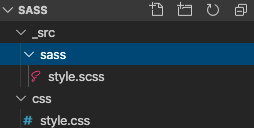How to Compile Sass with Gulp
Thu Dec 5, 2019
These are my notes from automating Sass compilation using Gulp.
Detailed information can be found on the official website.
First, set up your folder structure as follows:

Installing Gulp:
sass$ npm init
sass$ npm install -D gulp-cli
sass$ npm install -D gulp
sass$ npm install -D gulp-sass
Create a gulpfile.js:
'use strict'
var gulp = require('gulp');
var sass = require('gulp-sass');
gulp.task('sass', function(){
return gulp.src('./_src/sass/**/*.scss')
.pipe(sass({outputStyle: 'expanded'}))
.pipe(gulp.dest('./css'));
});
gulp.task('watch', function(){
gulp.watch('./_src/sass/**/*.scss', gulp.task('sass'));
})
gulp.task('default',gulp.series('watch'));
Try running gulp:
sass$ npx gulp
This is the basic setup.
Further automation settings would be needed, but I found gulp to be cumbersome, so I stopped using it.
In the end, I opted for a simpler approach.
Setting up a Sass environment and simplifying HTML common parts
Tags
Sass
See Also
